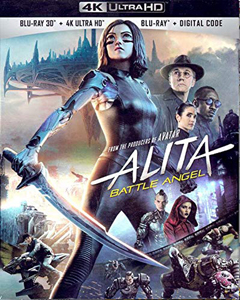It’s hard to predict a decade’s place in history while you’re living it, but the 2010s strike me as a Gateway to the Future. So many movies came out that blurred the line between humans and artificial intelligence that it has become a played-out theme; when cyborgs start walking among us for real, it might be ho-hum.
At least we’ve seen different angles into this classic SF theme: AI that has no body (“Her”), AI that has a body (“Ex Machina”), humans who operate outside their bodies (“Ready Player One”), and in the decade’s last blast of the idea, humans who have an artificial body – “Alita: Battle Angel.”
Futuristic mix of live-action and CGI
With “Avatar’s” James Cameron on board as a co-writer (with “Terminator Genisys’ ” Laeta Kalogridis), it’s not surprising that “Alita” features a new cinematic approach – but I’m not totally sure what the point of it is. The title character is played by Rosa Salazar but her face is CGI’d. This gives her the big eyes of Yukito Kishiro’s manga comic source material and an overall smooth, artificial look.

“Alita: Battle Angel” (2019)
Director: Robert Rodriguez
Writers: James Cameron, Laeta Kalogridis (screenplay); Yukito Kishiro (graphic novel)
Stars: Rosa Salazar, Christoph Waltz, Jennifer Connelly
Overall, Alita is a likable lead as she goes through her origin story, and she is a cool-looking action hero, especially when she adds a sword and high-speed rollerblades to her repertoire. But in the emotional moments – with Alita’s father figure and cyber-doctor Ido (the versatile Christoph Waltz) or love interest Hugo (Keean Johnson) – I wonder if they would have more impact if she was straight-up portrayed by the actor, free of CG alterations.
After all, many other cyborgs in the film have their totally human faces, with their bodies CGI’d into robotic form. The bounty hunter Zapan (Ed Skrein) reminds me of Joel Kinnaman’s title character in the “Robocop” remake, and also the “Star Wars” Legends Marvel comics character Kligson. He is in relatable bipedal form. More extreme examples of cyborgs come in the Battleball games, which feature human faces on huge killer machines, namely Jackie Earle Haley’s Grewishka.
(On the topic of “Star Wars,” in his early drafts for the first film, George Lucas delved into the fascinating but unfashionable idea that people increasingly lose their goodness as their bodies become more robotic. That’s softened in the finished films, although there is a remnant of the idea in Obi-Wan’s observation that Darth Vader “is more machine now than man; twisted and evil.” In “Alita,” though, being a cyborg does not automatically make one good or evil; same with being a wholly biological human.)
Maybe director Robert Rodriguez (“Planet Terror”) and his team are trying to make us love animated characters at the same time they’re teaching us to love a cyborg lead. Maybe Alita looks different because she is from the Martian side of the war (which is 300 years in the past at the time of the movie’s 26th century events). However, we are told her brain is human.

Cyborgs and meat-bags
In this cyberpunk future, it’s so common for human brains to keep going long after the body has been destroyed that the nastier cyborgs make fun of traditional humans, calling them meat-bags. But mostly, humans and cyborgs walk side by side down the streets of Iron City, the only functioning metropolis on Earth.
Ever-present above them is Zalem, that classic forbidden, fabled and heavenly city, like Providence in the “Divergent” films. (Indeed, there is a YA tint to “Alita” in its dystopia and youthful romance, and the production design sometimes has a slick sheen.) With “Alita” clearly being expensive yet not setting the box office afire, a sequel seems unlikely. But if there is one, I’d be interested to learn more about this world.
If this is it, we’re left with a one-film achievement that’s mostly technical. Iron City is one of those classic sprawling future burgs that’s fun to visit on screen although I wouldn’t want to live there; it looks clinically spectacular at times but in the end isn’t anything we haven’t seen before. It’s dangerous by day, more dangerous by night, and the populace only unites around a brutal, roller-derby style sporting event. It’s essentially the Hunger Games: The winner goes to Zalem, the losers are most likely dead.
This is another film that extrapolates the present-day conundrum wherein as technology gets better, the ruling class becomes more oppressive and people become less free. The future of “Alita” is both amazing and terrible.
Because it stands at the borders of human and cyborg, and live-action and CGI, “Alita” will likely be a popular film for scholars to cite as they look back at this Gateway to the Future decade. It checks the boxes of dystopian cyberpunk futurism. But the story and themes are too familiar for “Alita: Battle Angel” to stand out from the pack. I can see history being kind to this film, though, since the Rodriguez and Cameron names will earn it plenty of revisits.

